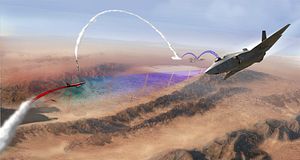The U.S. Navy and Marine Corps successfully tested the integration of two of their most advanced weapon platforms—the F-35B Lightning II and the Aegis Combat System—during a live fire missile exercise held at the White Sand Missile Range in New Mexico on September 13, according to a U.S. Navy press release.
The exercise involved a U.S. Marine Corps F-35B, acting as an elevated sensor, and transmitting data about incoming aerial threats to a ground station designed to simulate a ship at sea. The F-35B eventually detected an over-the-horizon threat and sent the data to the ground station connected to the Aegis Combat System. The incoming threat was successfully engaged and destroyed by a Standard Missile 6 long-range surface-to-air missile.
The live fire drill was designed to test the U.S. Navy‘s new air warfare concept, known as Naval Integrated Fire Control-Counter Air (NIFC-CA), and is focused on improving situational awareness and extended-range cooperative targeting. NIFC-CA is part of the U.S. Navy’s new distributed lethality naval surface warfighting concept. The September 13 test confirmed the compatibility of the two weapon systems, with the F-35B acting as a broad area sensor and thereby increasing the Aegis Combat System’s capability to detect, track, and destroy targets.
“This test was a great opportunity to assess the Navy’s ability to take unrelated technologies and successfully close the fire control loop as well as merge anti-surface and anti-air weapons into a single kill web that shares common sensors, links, and weapons,” said Anant Patel of the U.S. Navy’s Naval Sea Systems Command.
“NIFC-CA is a game changer for the U.S. Navy that extends the engagement range we can detect, analyze, and intercept targets,” noted Dale Bennett, executive vice president of Lockheed Martin Rotary and Mission Systems, according to a Lockheed Martin press release.
“One of the key defining attributes of a 5th Generation fighter is the force multiplier effect it brings to joint operations through its foremost sensor fusion and external communications capabilities,” according to another Lockheed Martin representative. “Those attributes were successfully proven at White Sands Missile Range in a very realistic demonstration of distributed lethality leveraging a U.S. Marine Corps F-35B and the U.S. Navy’s Aegis Weapon System.”
The U.S. Marine Corps plans to purchase 420 F-35 Lightning II aircraft, including 340 F-35B and 80 F-35C models, the plane’s carrier variant. Overall, the Pentagon is planning to procure 2,457 F-35 aircraft of all variants by 2038. Aegis is considered to be one of the world’s most advanced combat systems offering integrated air and missile defense capabilities to the U.S. Navy’s surface warships.

































